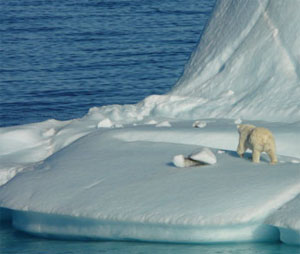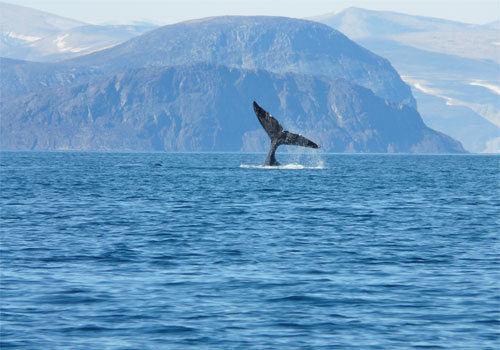This past summer, Dalhousie Environmental Science graduate Caitlyn MacMaster spent two weeks in the Canadian Arctic as part of an International Polar Year education initiative. As a chaperone with Students on Ice, Caitlyn cruised the east coast of Baffin Island with a team of scientists, environmental visionaries, artists, respected Inuit figures, and enthusiastic students. She writes about how her experiences at Dalhousie played a role in understanding the Arctic.
I am a person of extremely varied interests and an insatiable appetite for learning. As a student at Dalhousie, I felt plagued by an inability to stick with one major; perpetually changing my course of study every couple of months, before finally choosing environmental science—something sufficiently broad that I could continue to pursue all my varied interests.
SEE PHOTOS: Caitlyn MacMaster's photos from her Arctic expedition
SEE VIDEO: Polar bear dip
Last summer, I discovered this indecision was not a downfall, but a boon! The breadth of my uniquely tailored education at Dalhousie provided the perfect framework within which to understand the variety of experiences that my Arctic expedition offered—from Inuit culture and history to the geologic formation of the glacier-carved landscape. In this article, I focus on observations relating to climate change, and even in this narrow slice of my Arctic experiences, I relied on a variety of different disciplines.
 |
| A well-fed mature male polar bear wakes from his slumber on a colossal iceberg. (Caitlyn MacMaster Photo) |
The climatologist/oceanographer in me was thrilled to expand upon my knowledge of the role of ocean currents in climate, by delving deeper into heat transport to the Arctic via ocean currents. An integrated system of surface and deep-water currents, known as the “Global Conveyor Belt,” transports heat away from the equator and toward the poles. This mechanism warms the poles and cools the equator, making each region much more habitable than it would otherwise be.
However, by this very mechanism, the effects of global climate change are expected to manifest sooner and more drastically at the poles than almost anywhere else on the planet. As heat is transported so effectively away from the equator and toward the poles by these ocean currents, a 1 Celsius degree increase in the average temperature at the equator translates to an increase of approximately 7 Celsius degrees at the poles. Equivalently, if the average temperature on Earth increases by 2 Celsius degrees, it is predicted that the temperature at the poles will have risen by 10 Celsius degrees.
The effects of this warming are already manifesting themselves in the loss of sea ice (the “polar ice cap”). The minimum sea ice extent in 2007 was the lowest on record since satellite monitoring commenced in 1979. There was a slight rebound in 2008, but scientists are not encouraged; it is believed that the actual volume of ice remaining is less, as the ice is believed to be thinner. Thinner ice will melt faster come springtime, contributing to future ice losses.
There is a phenomenon at play here called the ice albedo feedback—a concept that was covered in my oceanography and atmospheric science studies at Dal. Simply put, water absorbs more heat from incoming solar radiation (i.e. sunlight) than does ice, because the water is darker—just as wearing a black shirt on a sunny day heats a person up faster. Warmer water doesn’t freeze as readily, so less ice is formed. Less bright sea ice and more exposed dark water means progressively more of the sun’s energy is absorbed, rather than reflected, and the water continues to heat up. The progressive sea ice losses essentially spiral out of control, through what’s known as a positive (or amplifying) feedback loop.
The rapidly diminishing sea ice provides critical habitat for a variety of Arctic species—and therefore its loss is a cause for serious concern. For example, polar bears are known to be powerful swimmers (something I can now vouch for based on first-hand experience!), travelling at times up to 100 kilometres in a single day. But they cannot swim indefinitely. As mammals, polar bears breathe air, so in order to rest, they need icebergs or sea ice, where they can sleep without worrying about staying afloat. However, as sea ice becomes scarcer, polar bears are finding rest stops to be fewer and farther between. In some unfortunate cases, polar bears that cannot find a place to rest drown, as fatigue takes over and they cannot remain afloat.
Declines in area and thickness of sea ice can also limit the area and time duration available for hunting. This may result in malnourished polar bears that cannot survive the winter hibernation or that wake early, due to the hunger, at times when food sources are not readily available. Inuit hunters are facing similar challenges in finding enough food. Many are braving increasingly dangerous conditions to provide nourishment for their families, as they range onto thinner and thinner ice out of desperation. The traditional ways of reading the weather to predict danger are no longer reliable and food is not abundant enough to meet their needs. This combination has proven fatal to many local hunters.
Seals, too, are affected by the decline in sea ice. As mammals, seals breathe air and give live birth. They rely on sea ice for safe birthing grounds. As sea ice declines, pup mortality is sky-rocketing, reaching close to 100 per cent in some extreme cases.
 |
| An endangered bowhead whale gets playful in Isabella Bay. After 25 years of lobbying, this important habitat for the bowheads was finally granted protection in August 2008. (Caitlyn MacMaster Photo) |
Whales are also indirectly affected by the loss of sea ice. In biology class, we learned that whales feed on plankton and krill, which in turn feed on phytoplankton—microorganisms that rely on photosynthesis for energy production. Physical oceanography tells us that as sea ice melts, it creates a freshwater ‘cap’—a layer of less dense water that sits on top of the salt water and therefore resists vertical mixing. Thus, plankton in the freshwater remain closer to the sunlight and are more productive. The plankton bloom can be seen from space—as satellites identify chlorophyll concentrations by examining the color spectra of the light reaching their sensors—and each year it follows the sea ice melt. Without that freshwater cap, phytoplankton production could be expected to decline, which would limit food availability for whales, like the endangered Bowheads we visited in Isabella Bay.
In today’s world—especially in academia—we are encouraged to be specialists. For me, being a generalist is not such a bad thing. My broad background in Environmental Science and Oceanography at Dalhousie provides me with a plethora of tools with which I may interpret my experiences, from daily occurrences to trips of a lifetime. So if I had to choose one piece of wisdom to pass along, here’s what I’d advise: Pursue your passions—whatever they are—and make your education fit your life, not the other way around! In this way, your formal education has the greatest potential to enhance your everyday life!
Dalhousie graduate Caitlyn MacMaster is a wind energy consultant with M.K. Ince and Associates in Ontario. She remains interested in environmental and climatological education and intends to pursue graduate studies in the natural sciences at some future date.
